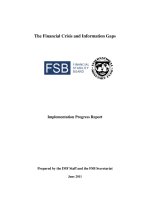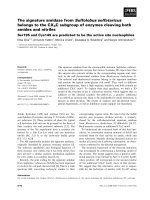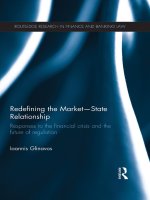Bayoumi unfinished business; the unexplored causes of the financial crisis and the lessons yet to be learned (2017)
Bạn đang xem bản rút gọn của tài liệu. Xem và tải ngay bản đầy đủ của tài liệu tại đây (2.9 MB, 297 trang )
The Unexplored Causes of the Financial Crisis
and the Lessons Yet to be Learned
“Both o
riginal
and pe
demon
rsuasiv
strates
e, this b
t
h
lessons
at we s
ook
till have
to learn
importa
from th
is deva
nt
stating
MARTI
crisis.”
N WOL
F
TAMIM
BAYOUMI
UNFINISHED BUSINESS
i
ii
UNFINISHED
BUSINESS
The Unexplored Causes of
the Financial Crisis and the
Lessons Yet to be Learned
TAMIM BAYOUMI
YALE UNIVERSIT Y PRESS
NEW HAVEN AND LONDON
iii
Copyright © 2017 International Monetary Fund
All rights reserved. This book may not be reproduced in whole or in part, in any form
(beyond that copying permitted by Sections 107 and 108 of the U.S. Copyright Law and
except by reviewers for the public press) without written permission from the publishers.
Nothing contained in this book should be reported as representing the views of the IMF,
its Executive Board, member governments, or any other entity mentioned herein. The
views expressed in this book belong solely to the authors.
For information about this and other Yale University Press publications, please contact:
U.S. Office: yalebooks.com
Europe Office: yalebooks.co.uk
Set in Minion Pro by IDSUK (DataConnection) Ltd
Printed in Great Britain by TJ International Ltd, Padstow, Cornwall
Library of Congress Control Number: 2017942755
ISBN 978-0-300-22563-1
A catalogue record for this book is available from the British Library.
10 9 8 7 6 5 4 3 2 1
iv
To Susan, Elisa, and Stefan
For giving me joy and purpose
v
vi
CONTENTS
List of Figures
Acknowledgements
Introduction: The Needle (and the Damage Done)
viii
x
1
PART I: ANATOMY OF THE NORTH ATLANTIC FINANCIAL CRISIS
1 European Banks Unfettered
2 US Shadow Banks Unleashed
3 Boom and Bust
15
44
71
PART II: MISDIAGNOSING THE NORTH ATLANTIC ECONOMY
4 A Flawed Monetary Union
5 Intellectual Blinkers and Unexpected Spillovers
6 A History of the International Monetary System in Five Crises
109
133
156
PART III: COMPLETING THE CURE
7 Will Revamped Financial Regulations Work?
8 Making Macroeconomics More Relevant
9 Whither EMU?
185
207
229
Final Thoughts
250
Notes
References
Index
256
265
273
vii
FIGURES
1. Output losses were the highest in the Euro area periphery.
2. Output losses were mainly in the North Atlantic region.
3. Estimated output losses in Euro area crisis countries.
4. Euro area banking boomed after 1985.
5. Investment banking in the Euro area core expanded rapidly
after 1996.
6. Most European bank mergers involved domestic agglomeration.
7. Euro area banks were largely national in 2002.
8. Euro area mega-banks were already becoming too big to fail.
9. Mergers in the late 1990s completed the European mega-banks.
10. Internal risk models led to thin capital buffers.
11. Structure of Euro area banking in 2002.
12. Regulated banking did not grow from 1980–2002.
13. Securitization of mortgages boomed after 1980.
14. Banks sold most mortgages via securitizations by 2002.
15. Balance sheets of broker-dealers, the core of investment banks,
exploded.
16. Emerging national banks became increasingly important.
17. GSEs and investment banks had thin capital buffers in 2002.
18. Structure of US banking in 2002.
19. The North Atlantic financial boom.
20. Euro area bank assets grew rapidly after 2004.
21. Investment banking grew in the Euro area core, expansion was
more balanced in the periphery.
22. Core Euro area banks expanded overseas.
23. Euro area mega-banks grew rapidly after 2004.
viii
6
7
11
34
34
36
38
39
39
40
42
63
64
65
66
67
68
69
72
87
87
88
89
FIGURES
24. Capital buffers of Euro area mega-banks thinned.
25. Basel capital ratios became increasingly misleading.
26. Private mortgage securitizations surged after repo collateral
was widened in 2003.
27. Foreign banks borrowed more cash via repos after 2003.
28. Investment and national banks grew rapidly through 2007.
29. Thinly capitalized banks faced more trouble over the crisis.
30. The size and increase of the European banks stands out.
31. From 1998 to 2008 the US went on a spending spree.
32. The Euro area periphery went on a similar spending spree to
the United States.
33. Periphery bond yields converged to Germany's before the crisis.
34. Investment spending surged in the Euro area periphery before
the crisis.
35. Residential spending drove higher investment.
36. Investment spending was increasingly important in the US.
37. US residential investment surged in the 2000s.
38. US and Euro area periphery experienced similar house price
booms.
39. Falling US yields reflected inflows from emerging markets,
European banks, and repos.
40. US output growth stabilized after the mid-1980s.
41. US international debt outflows are highly volatile.
42. Crises are more costly for emerging markets.
43. Global costs of crises rose with globalization.
44. Debt outflows dominate in crises.
45. Misery index for the major players in the crises.
46. Euro area core bank assets have shrunk more than those
in the periphery.
47. Euro area core banks have pulled back from the periphery
and the US/UK.
48. Mega-bank assets have shrunk but remain a large component
of the Euro area banking system.
49. Euro area mega-banks have strengthened capital buffers.
50. US commercial bank assets rose after the crisis, investment bank
assets contracted rapidly.
51. Private securitization has dwindled.
52. Capital increased most for investment banks.
53. Trade between initial EMU entrants expanded moderately.
54. The US remains a more coherent currency union than the Euro
area.
ix
90
91
92
92
93
94
96
98
98
99
100
100
101
101
102
103
140
159
176
176
177
181
200
201
202
202
203
204
205
239
242
ACKNOWLEDGEMENTS
Many people have helped me with this book. In addition to the IMF, which
granted me a sabbatical, pride of place goes to Adam Posen, the director of
the Peterson Institute for International Economics, the institution that
gave me an office and made me a senior fellow, which allowed me to
interact with their fantastic fellows and staff. In particular, during my stay,
in addition to Adam, I benefited enormously from conversations with Fred
Bergsten, Bill Cline, Nicolas Véron, Simon Johnson, Morris Goldstein, Joe
Gagnon, Ana Gelpern, Steve Weisman, Jacob Kierkegaard, Patrick
Honohan, Olivier Blanchard, Chad Brown, Monica De Bolle, Marcus
Noland, Jérémie Cohen-Setton, Caroline Freud, Olivier Jean, Rory
MacFarquhar, Jeff Schott, Ted Truman, Dave Stockton, and Jeromin
Zettelmeyer. Their intellectual generosity is an example for us all.
Additional important inputs came from Ashok Bhatia of the IMF, who
explained the US financial system in terms even I could understand, David
Marsh from OMFIF, who constantly encouraged me, and Barry Eichengreen
of Berkeley and Harold James of Princeton, who both commented on
earlier versions of the text. Many thanks also go to Taiba Batool, my editor,
who helped knock the book into shape, and Anish Tailor of the Peterson
and Jelle Barkema of the IMF for their invaluable research assistance.
Thanks also to Lauren Pettifer, Melissa Bond, and Jennie Doyle at Yale
University Press for helping with the finishing touches. Finally, it is important to acknowledge that this book represents my own views, and does not
necessarily represent those of the IMF, IMF policy or the Peterson Institute
for International Economics.
x
INTRODUCTION
The Needle (and the Damage Done)
It is often said that it takes a decade to turn current events into history, a
reckoning that probably makes this the first true history of the North
Atlantic financial crisis.* The moniker is apt, as this narrative chronicles
how after 1980 a succession of missteps by financial regulators, aided and
abetted by policy makers’ intellectual blind spots, made the North Atlantic
banking system so brittle that the failure of a medium-sized US investment
bank toppled the world into the worst recession since the 1930s and the
Euro area into a depression. It highlights the crucial and under-appreciated
role played by increasingly shaky northern European mega-banks in
financing remarkably similar financial bubbles in the US and southern
Europe, which parasitically intertwined with the better known but equally
misunderstood expansion of shaky US shadow banks. The common origin
of the US and Euro area crises has been missed because it was overlaid by
the longer and deeper Euro area recession coming from a flawed currency
union that left often cash-strapped national governments responsible for
expensive bank rescues. While some of the mistakes in the North Atlantic
economy have been rectified, there remains an awful lot of unfinished
business before we can be confident that the world will not continue to
face serial financial instability and lackluster growth.
***
* A central argument of this book is that the 2008–09 US financial crisis and the 2008–12
Euro area crisis were joined at the hip, hence the descriptor the North Atlantic crisis.
1
2
UNFINISHED BUSINESS
The Needle
The North Atlantic crisis is generally dated from the early afternoon of
August 9, 2007, Paris time, when this press release flashed on dealers’ screens:
BNP Paribas Investment Partners temporally suspends the calculation of
the Net Asset Value of the following funds: Parvest Dynamic ABS, BNP
Paribas ABS EURIBOR and BNP Paribas ABS EONIA
The complete evaporation of liquidity in certain market segments of
the US securitization market has made it impossible to value certain
assets fairly regardless of their quality or credit rating. The situation is
such that it is no longer possible to value fairly the underlying US ABS
assets in the three above-mentioned funds. We are therefore unable to
calculate a reliable net asset value (“NAV”) for the funds.
In order to protect the interests and ensure the equal treatment of
our investors, during these exceptional times, BNP Paribas Investment
Partners has decided to temporarily suspend the calculation of the net
asset value as well as subscriptions/redemptions, in strict compliance
with regulations, for the following funds:
• Parvest Dynamic ABS effective 7 August 2007, 3pm (Luxembourg
time)
• BNP Paribas ABS Euribor and BNP Paribas ABS Eonia effective 7
August 2007, 1pm (Paris time)
The valuation of these funds and the issue/redemption process will
resume as soon as liquidity returns to the market allowing NAV to be
calculated.
In the continued absence of liquidity, additional information on the
envisaged measures will be communicated to investors in these funds
within one month of today.
Thursday, August 9 was an unappealingly cold and windy day in Paris
even before this chilly financial message. Indeed, it turned out to be the coldest
day of the month, with an overnight low of 11 degrees Celsius (51 degrees
Fahrenheit) rising to a modest 18 degrees Celsius (64 degrees Fahrenheit) in
the afternoon. On top of that it was blowy, with average winds of 16 kilometers
per hour (10 miles per hour). At least it did not rain, in contrast to the otherwise similar days before and after. In short, it was not a pleasant few days to be
a banker in Paris. Not that there were many bankers left in the city. The French
predilection for taking August as vacation left Paris largely bereft of workers,
replaced by the usual throngs of (in this case often shivering) tourists.
INTRODUCTION
3
The head of BNP Paribas asset management, Gilles Glicenstein, authorized the press release from the semi-deserted BNP Paribas offices just a
block from the Arc de Triomphe. Gilles was a well-respected up-andcoming banker who was known for being decent and careful, as well as for
running marathons. He had joined BNP after four years at the French
Ministry of Finance. He never regretted his decision to send out the press
release, which he firmly believed had been the right thing to do. Tragically,
he died of cancer in the spring 2009 at age 44.
The press release underlined how problems initially seen as a minor blip
in US mortgages were affecting the European as well as US banks. The
“certain segments” of the mortgage market that were in distress were securities that bundled subprime mortgages or securities that put these assets
together into more complex collateralized debt obligations (CDOs) or even
into CDOs-squared (CDOs of CDOs). The roaring market in these products
rapidly collapsed as it became apparent that US house prices were falling,
something that the proponents of these products had assured investors had
not happened on a national basis in the United States in the sixty years since
World War II. This unexpected development undid a market in which
subprime mortgages had increasingly been issued with minimal assessment
of the creditworthiness of the borrowers on the happy assumption that
continued house price increases would validate the loans. The mortgagebacked securitization market collapsed along with its central dogma.
The BNP announcement was the second major blow to the European
banking system from US subprime mortgages, coming less than a fortnight
after the rescue of IKB Deutsche Industriebank AG. IKB was a small
German bank specializing in loans to medium-size enterprises that was
brought down by unwise investments in assets backed by subprime loans.
In many ways, IKB was the more important financial shock. Jochen Sanio,
the lead German bank regulator, is reported to have said that the hurried
weekend rescue involving a wide swathe of the German banking industry
(an arrangement designed to circumvent EU rules on state subsidies) was
needed to avoid the worst banking crisis since 1931.1 However, the
symbolism of having part of the business of the largest French bank felled
by turmoil in US markets has remained the more potent talisman of the
wider impact of the North Atlantic crisis, a somewhat ironic outcome as
BNP Paribas actually weathered the crisis relatively successfully.
The financial chill that settled over Europe in the summer of 2007 has
yet to be fully lifted. After reaching a peak in mid-July 2007, the rescue of
IKB lowered Euro area equity prices by 5 percent and the subsequent BNP
announcement wiped out another 5 percent.2 After a brief rally later in the
4
UNFINISHED BUSINESS
year, the stock market started a long descent, falling to a nadir of under half
its peak value in early 2009. A decade later, it is still below its July 2007 value.
The BNP announcement was also the moment when the two most
powerful central banks in the world started finding their traditional policy
responses were largely ineffective. The press release prompted an injection
of liquidity into the markets by the European Central Bank that was a
precursor to many such moves on both sides of the Atlantic as well as policy
rate cuts by the US Federal Reserve. Such palliatives had only limited effects,
given market jitters coming from uncertainty about the viability of major
banks. This financial equivalent of a phony war ended with the market
panic that followed the collapse of Lehman Brothers, a mid-sized US investment bank, on September 15, 2008. The subsequent freezing of North
Atlantic financial markets, global recession, and painfully slow recovery
have forced both central banks to dabble with all sorts of “unconventional”
policies such as buying assets and lowering interest rates below zero.
***
The Damage Done
Before outlining the origins of the North Atlantic crisis it is worth underlining its massive costs. Calculating the economic losses from a crisis is
never easy. For example, it is not enough to simply focus on the output
losses after the crisis, as these must be set against the booms that economies
experience before financial bubbles burst. Indeed, in normal times economists assume that expansions (when output moves above potential) are
offset by recessions (when output falls below potential) so that output is on
average at its trend. However, financial busts are different as the disruption
coming from sudden losses in access to loans can lead to major net losses in
output. In the calculations below, the losses over the cycle are calculated
using International Monetary Fund estimates of the deviation of output
from its potential value from 2003 to 2021.3
Another cost of the financial crisis was the waste due to excessive investment in the crisis countries. In the national accounts, investment is measured
by the cost of building (say) a house even though the benefits come only after
people start living there. In general, it is safe to assume that each dollar put
into housing generates somewhat more than a dollar of value in the future
(since investors need to be compensated for patience and risk). In a bubble,
however, investments can be much less productive. In the 2000s, a good
chunk of the money poured into, for example, Spanish housing went into
INTRODUCTION
5
overbuilt neighborhoods in the wrong places. Such funds could have been
much more usefully used to buy machinery, such as computers, or simply
been given back to shareholders as dividends. Below, it is assumed that for
the crisis countries (the United States, Italy, Spain, Greece, Ireland, and
Portugal) any construction spending above the ratio to output prevailing in
late 1999 was worth only 50 cents rather than a dollar, which implies that
about one-tenth of all spending on construction was wasted.
There were also spillovers to other parts of the world, particularly the
core of the Euro area (Germany, France, the Netherlands, and Belgium)
whose banks provided much of the financing that supported excessive
lending in the United States and the Euro area crisis countries. The resulting
banking problems boomeranged back on the core economies. It also
included many innocent bystanders, such as the emerging markets that
were hit by the wholesale pullback from risky assets as well as the collapse
in demand for durable goods in the US and Euro area and associated knockon to their exports.4 This suggests three levels of analysis: The costs accruing
to the crisis countries themselves, those applying to the rest of the Euro
area, and those accruing to the rest of the world.
Putting this together, the United States suffered cumulative losses of
around 10 percentage points of output while the typical Euro area crisis
country experienced losses of more like 25 percent of output, with the
composition varying in an intuitive manner (Figure 1). For example, in
Ireland and Spain the bulk of the losses come from inefficient housing
investment rather than the cycle since the real estate bubbles were large, the
boom before the crisis was extensive, and the recovery from the downturn
was relatively fast (details of the calculations for the Euro area crisis countries are provided in Figure 3 at the end of this chapter). Elsewhere, including
the United States, direct output losses dominate.
The spillovers to the core of the Euro area from the extended downturn
total about 10 percent of output, similar to the United States but less than
half that of the crisis countries. These losses reflect the financial problems
these countries encountered due to imprudent lending to the United States
and Euro area periphery, exacerbated by the inefficient design of the Euro
area, where a structure that was intended to shield the rest of the region
from national fiscal and financial shocks in practice amplified such spillovers. In the rest of the world, the losses come more from the immediate
impact of the downturn on output. Output in emerging and developing
countries, which make up the bulk of the remaining countries, fell by
3 percentage points in 2009 but then rebounded robustly in the subsequent
two years for an implied loss in output of around 4 percent.
6
UNFINISHED BUSINESS
Losses as a percent of GDP
25
20
15
10
5
0
US
Euro area
crisis
Cyclical losses
Euro area
remainder
Rest of
the world
Investment losses
Figure 1: Output losses were the highest in the Euro area periphery.
Source: Haver Analytics.
Overall, the final tally of damages is estimated at some $4½ trillion in
2009 prices or around 8 percent of world output in that year (Figure 2). Put
another way, it is as if the world economy shut down completely for a
month—no factories, no supermarkets, no electricity, no restaurants, and
no new cars. Most of the losses were in the North Atlantic region, with the
Euro area crisis countries suffering larger losses than the core, and the Euro
area as a whole suffering greater losses than the United States. The crisis
cost the rest of the world “only” about $1¼ trillion. Striking as these numbers
are, these deliberately conservative calculations are at the low end of estimates of losses from financial crises as they take no account of longer-term
costs coming from the erosion in job skills and debilitating impact of lower
investment by firms.5 Less conservative assumptions produce losses of
more like 65 percent of output from a typical financial crisis, and can run as
high as 140 percent.6 Using the 65 percent figure for the US and the Euro
area crisis countries quadruples the global losses—equivalent to a fourmonth global shutdown. However you calculate it, the North Atlantic crisis
was a massive blow to the global economy.
The stagnation in incomes after the crisis also generated a political
backlash against the existing order and associated economic “experts”.7 This
is exemplified by the British decision to leave the European Union, the election of President Trump, and the growing support for populist parties in
the Euro area. These deep changes in popular sentiment underline the
importance of the North Atlantic crisis as a watershed economic, political,
and social event. Commensurate with the size of this event, the rest of this
7
INTRODUCTION
Rest of
the world
US
Euro
area core
Euro
area crisis
Figure 2: Output losses were mainly in the North Atlantic region.
Source: Haver Analytics.
book explores the historical background that allowed the crisis to occur,
and outlines the resulting policy responses and lessons. It focuses on the
two regions most affected by the crisis, the Euro area and the United States,
and discusses the experiences of other North Atlantic countries such as the
United Kingdom and Switzerland only insofar as they pertain to these
events. Despite the obvious attractions of including the Swiss and UK experiences (both countries experienced major banking problems) their
addition would have involved adding a lot of country-specific detail without
a commensurate increase in underlying insights.8
***
What Went Wrong
There have been many books about the crisis that followed the 2008 collapse
of Lehman Brothers in the United States and the 2009 admission of the size
of Greek debt in the Euro area. At the risk of oversimplification, the main
strand of the US literature involves blow-by-blow accounts of the crisis in
which (for example) large and complex banks appear fully formed, while the
equivalent narratives on the Euro area are similar except that they provide
greater historical background on the creation of the currency union.9 In
both cases, the focus on how policymakers reacted to the new and largely
unexpected challenges. In the United States, these include how to provide
financial support to institutions that were outside of the Federal Reserve’s
traditional safety net, how to sort through the long chains of ownership
8
UNFINISHED BUSINESS
because of banks selling mortgage loans using securitizations, and how to
deal with overinflated credit ratings. On the Euro area side, the challenges
include regaining access to dollar liquidity, how to respond to market jitters
about the solvency of banks, sovereigns, and their interaction, and how to
enforce policy conditions on member countries. The experiences from these
challenges are then used to distill lessons for the future. Finally, there is also
a strand of the literature that uses the crisis to explore the instability of
financial systems in capitalist economies and offer policy solutions.10
This book takes different and more holistic approach by examining the
origins of the joint North Atlantic crisis. Rather than using the prism of
the immediate crisis to distill lessons, it asks what can be learned from the
process by which the North Atlantic region got itself into a position where
such a cataclysmic crisis could occur. For example, rather than looking at
the problems caused by securitization (the bundling of mortgages and
other loans that were then sold to investors), it asks what drove the banks to
want to sell mortgages through securitized markets in the United States and
not in Europe. Similarly, rather than looking at the problems caused by
massive European banks whose governments found difficult to bail out, it
asks what led to the creation of so many mega-banks in Europe compared
to the United States. Rather than focusing on the different triggers and
responses to the US and European crisis, it asks why the major northern
European banks were so involved in financing unsustainable financial
bubbles in the United States and the Euro area periphery.
A parallel with the literature on World War I may provide a useful
analogy. At the end of that bruising conflict there was again a desire to
assess the lessons coming from the immediate experience of the war. This
focus generated heroes, such as Lawrence of Arabia, and villains, most
importantly the leaders of Germany who were seen as bent on aggression.
Over time, however, the literature on the origins of World War I has come
to a much more nuanced view in which the war is seen largely as the interaction of a range of diplomatic imperatives over a long period.11 Alliances
hardened, military plans were refined, so that when the denouement
occurred most of the actors felt like “sleepwalkers”.
Similarly, in the wake of the North Atlantic financial crisis there has
been a focus on heroes, the policymakers, and villains. In the United States,
the villains have generally been reckless financial firms run by greedy and
crooked bankers aided and abetted by captured regulators.12 In Europe, the
narrative more often involves malfeasance before the crisis by the central
government (Greece), local governments (Spain), bankers (Ireland), and
connected firms (Portugal and Italy), followed by an intransigent insistence
INTRODUCTION
9
on maintaining the rules in the face of the crisis by the Germans, due either
to the dominance of market-orientated thinking across the elites or to
divergences in the historical experience of the French and Germans.13
This book incorporates these perspectives, but argues that the structural
defects that led to the North Atlantic crisis were more complex and came
from a much wider range of actors and motivations. This perspective generates a narrative with fewer heroes or villains. This is not to say that there
were not greedy and crooked people in banks in the US and Ireland
or malfeasance elsewhere in the Euro area. There undoubtedly were. But
then such people always exist. The point is that you can tell a narrative
of the origins of the North Atlantic crisis without malfeasance being a
central plank. Just as was the case for World War I, most people were playing
roles that had been laid out because of earlier decisions—they were sleepwalkers. The system failed, not the individuals. Accordingly, I have almost
exclusively used pre-crisis accounts to explain their actions.
Another parallel with World War I comes from the unexpected nature of
the North Atlantic crisis, which added immensely to the subsequent costs.
In 2008 nobody expected problems in US subprime loans, a seemingly
small segment of finance, to fell the entire North Atlantic economy just as,
in the run-up to August 1914, misplaced confidence in the ability of the
Concert of Europe to finesse earlier crises led to diplomatic complacency
over the apparently peripheral assassination of the heir to the AustroHungarian Empire by a Serb patriot. The unexpected nature of the North
Atlantic crisis matters as it forced policymakers to improvise. Unsurprisingly,
some of these decisions were successful while others were not. US policymakers vastly underestimated the impact of allowing Lehman Brothers to
go bankrupt. Euro area policymakers were similarly hamstrung by the rules
that constrained the Euro area from providing adequate support to crisis
countries.
A final parallel with World War I is adequacy of the response. The
Versailles Treaty agreed in the aftermath of the war unsuccessfully tried to
patch up the pre-war economic order while punishing the Germans with
large reparation payments. It led to serial financial and economic instability—and also to World War II. By contrast, the more radical revamp of
the global economic order after World War II at the Bretton Woods
conference ushered in a long period of growth and prosperity. The crucial
question is whether the response to this crisis is a new Versailles or a new
Bretton Woods.
The first section of this book, “Anatomy of the North Atlantic Financial
Crisis”, explains how the North Atlantic financial system became so brittle.
10
UNFINISHED BUSINESS
There was indeed a powerful anti-regulatory lobby in the United States
comprising the large banks, the Federal Reserve, and (to a lesser extent)
the Securities and Exchange Commission (SEC). However, the philosophy
was not endorsed by other bank regulators, so that deregulation largely
affected the areas where the Federal Reserve and SEC held sway, the (already
lightly regulated) investment banks, securitization, and consumer protection of mortgages, even as the core regulated banking system remained
relatively sound. Crucially, however, the US anti-regulatory philosophy was
exported to the international banking system via the Basel Committee on
Banking Supervision, which allowed large international banks to use their
own internal models to calculate capital buffers for investment banking
operations. This had a particularly large impact on the Euro area, where
the European Commission had encouraged universal banking (universal
as it combined commercial and investment banking under one roof) and
the Maastricht Treaty on Economic Union left financial regulation in
the hands of national supervisors. With the scope of banks defined by the
Commission and capital buffers by the Basel Committee, national regulators became boosters for their national mega-banks. The resulting boom
in loans helped finance bubbles in the US housing market as well as the
Euro area periphery. In short, US deregulation did promote the US
and Euro area financial crises, but indirectly via Basel and mega-banks in
the Euro area.
The following section, “Misdiagnosing the North Atlantic Economy”,
explains why the financial and macroeconomic warning signs were missed.
The answer lies in intellectual overconfidence in the stability of private
markets that led to a compartmentalization of policy decisions based
on faulty underlying models. Disagreements on the purpose of the single
currency between Germany and France led to a flawed Euro area that
was designed for good times but not for bad ones. More generally, North
Atlantic policymakers underestimated the value of financial regulation and
the risks from free international capital flows, while overestimating the
ability of central banks to stabilize the economy in the face of shocks.
In sum, a free-market intellectual bubble obscured growing domestic, intraEuro area, and inter-Atlantic macrofinancial bubbles. This explains why the
crisis came as such a surprise, and why it was so costly to solve, particularly
for the Euro area.
The final section, “Completing the Cure”, examines the policy responses
to the crisis from this historical perspective. While much has been done to
correct the defects that became apparent during the crisis, many deeper
weaknesses remain. Examples include the continued focus on bank internal
11
INTRODUCTION
risk models in the Euro area, inadequate oversight of international debt
flows, limited buffers to respond to shocks to Euro area members that
are not prepared to submit to a program, and a new interest in reducing
financial regulations. More generally, the world seems to be drifting back
to policy compartmentalization, with monetary policy shouldering the
burden of raising growth out of its doldrums while backing away from
concerns about financial stability, despite calls for greater coordination
with fiscal, financial, and structural policies. There is still an awful lot of
unfinished business.
Country
Cycle
Investment
Total
Italy
-19.1
-6.8
-25.9
Spain
-4.9
-15.4
-20.3
Ireland
-5.0
-14.1
-19.1
Portugal
-31.9
0.0
-31.9
Greece
-30.0
0.0
-30.0
Figure 3: Estimated output losses in Euro area crisis countries. Percent of GDP.
Source: Haver Analytics.
12
PART I
ANATOMY OF THE NORTH ATLANTIC FINANCIAL CRISIS
13
14









